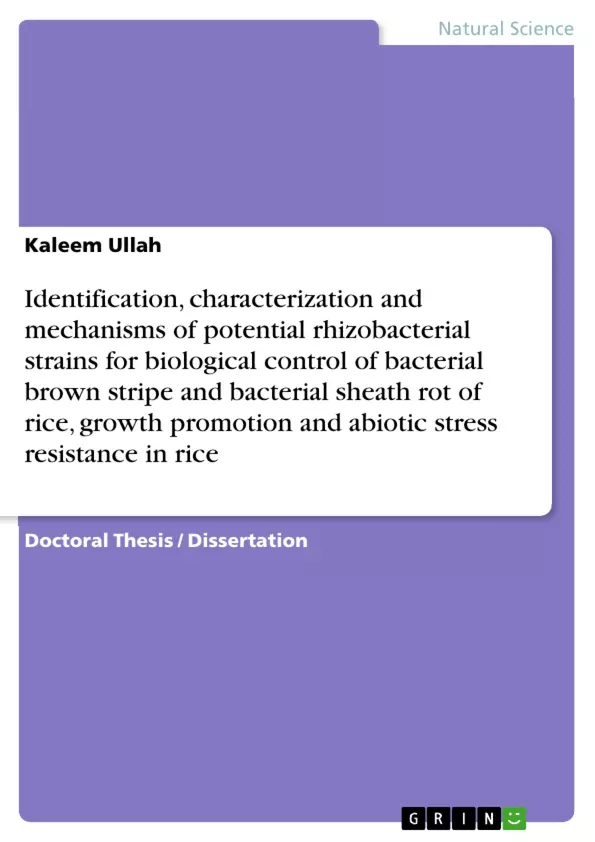Plant growth-promoting rhizobacteria (PGPR) are free-living, soil-borne bacteria that colonize the rhizosphere and, when applied to crops, enhance the growth of plants, protect from disease and induce systematic resistance against abiotic stress. The present study was undertaken to estimate the potential use of rhizobacterial strains to control the bacterial brown stripe (BBS) caused by A. avenae subsp. avenae and brown sheath rot caused by P. fuscovaginae respectively, under in vitro and in vivo conditions, and study their potential mechanisms. In addition, a consortium of these two PGPRs and different chemical inducers were used to induce systematic resistance in rice plants against abiotic stress including cold and drought.
Inhaltsverzeichnis (Table of Contents)
- Chapter 1: Introduction
- 1.1 Background
- 1.2 Objectives
- Chapter 2: Materials and Methods
- 2.1 Rice Materials and Experimental Design
- 2.2 Isolation and Screening of Rhizobacteria
- 2.3 Molecular Identification and Characterization
- 2.4 Biocontrol Efficacy and Mechanisms
- 2.5 Plant Growth Promotion
- 2.6 Abiotic Stress Tolerance
- 2.7 Statistical Analysis
- Chapter 3: Results
- 3.1 Isolation and Screening of Rhizobacteria
- 3.2 Molecular Identification and Characterization
- 3.2.1 Morphological and Biochemical Characterization
- 3.2.2 Molecular Identification
- 3.3 Biocontrol Efficacy of Selected Rhizobacteria
- 3.3.1 In Vitro Antagonism against Bacterial Brown Stripe and Bacterial Sheath Rot Pathogens
- 3.3.2 Greenhouse Pot Experiments
- 3.4 Mechanisms of Biocontrol
- 3.4.1 Production of Antimicrobial Compounds
- 3.4.2 Induction of Systemic Resistance
- 3.4.3 Competition for Nutrients and Space
- 3.5 Plant Growth Promotion
- 3.5.1 Plant Growth Parameters
- 3.5.2 Physiological and Biochemical Changes
- 3.6 Abiotic Stress Tolerance
- 3.6.1 Drought Stress Tolerance
- 3.6.2 Salinity Stress Tolerance
- Chapter 4: Discussion
- Identification and characterization of rhizobacterial strains with antagonistic activity against bacterial brown stripe and bacterial sheath rot pathogens
- Evaluation of the biocontrol efficacy of selected rhizobacterial strains in greenhouse pot experiments
- Investigation of the mechanisms underlying the biocontrol activity of rhizobacterial strains, including production of antimicrobial compounds, induction of systemic resistance, and competition for nutrients and space
- Assessment of the potential of selected rhizobacterial strains to promote rice growth and enhance its resistance to abiotic stresses, such as drought and salinity
- Development of sustainable and environmentally friendly approaches for managing rice diseases and improving rice productivity
Zielsetzung und Themenschwerpunkte (Objectives and Key Themes)
This dissertation aims to identify, characterize, and elucidate the mechanisms of potential rhizobacterial strains for biological control of bacterial brown stripe and bacterial sheath rot diseases in rice. The study also investigates the ability of these strains to promote rice growth and enhance its resistance to abiotic stresses.
Zusammenfassung der Kapitel (Chapter Summaries)
Chapter 1: Introduction provides an overview of bacterial brown stripe and bacterial sheath rot diseases in rice, highlighting their economic importance and the need for sustainable disease management strategies. The chapter also outlines the objectives of the research, which focus on identifying and characterizing potential rhizobacterial strains for biocontrol, growth promotion, and stress tolerance in rice.
Chapter 2: Materials and Methods describes the experimental procedures employed in the study, including the isolation and screening of rhizobacterial strains, molecular identification and characterization, biocontrol efficacy assessment, plant growth promotion evaluation, abiotic stress tolerance testing, and statistical analysis.
Chapter 3: Results presents the findings of the study, covering aspects such as the isolation and characterization of rhizobacterial strains, their biocontrol efficacy against rice pathogens, the mechanisms underlying their biocontrol activity, their impact on rice growth and yield, and their ability to enhance rice tolerance to abiotic stresses.
Chapter 4: Discussion provides an in-depth analysis of the results, discussing the implications of the findings for the development of sustainable and environmentally friendly disease management strategies for rice. The chapter also highlights the potential of rhizobacterial strains as a novel biocontrol agent and growth promoter for rice.
Schlüsselwörter (Keywords)
Rhizobacteria, biocontrol, bacterial brown stripe, bacterial sheath rot, rice, growth promotion, abiotic stress, drought, salinity, antimicrobial compounds, systemic resistance, competition, Bacillus, Pseudomonas.
- Citation du texte
- Kaleem Ullah (Auteur), 2014, Identification, characterization and mechanisms of potential rhizobacterial strains for biological control of bacterial brown stripe and bacterial sheath rot of rice, growth promotion and abiotic stress resistance in rice, Munich, GRIN Verlag, https://www.grin.com/document/456269



